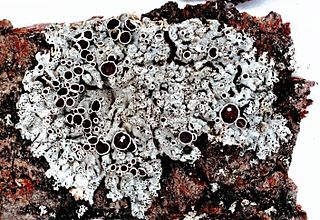
Physcia stellaris is a species of lichen. It is pale grey, but darker in the centre, and lacks isidia, lobules, soredia and pruina. It tests negative with potassium hydroxide. In North America, it is known colloquially as the fringed rosette lichen.
Irwin M. Brodo is an emeritus scientist at the Canadian Museum of Nature, in Ottawa, Ontario, Canada. He is an authority on the identification and biology of lichens. Irwin Brodo was honored in 1994 with an Acharius Medal presented to him by the International Association for Lichenology.

Bryoria fremontii is a dark brown, horsehair lichen that grows hanging from trees in western North America, and northern Europe and Asia. It grows abundantly in some areas, and is an important traditional food for a few First Nations in North America.

Caloplaca is a lichen genus comprising a number of distinct species. Members of the genus are commonly called firedot lichen, jewel lichen. gold lichens, "orange lichens", but they are not always orange, as in the case of C. albovariegata. The distribution of this lichen genus is worldwide, extending from Antarctica to the high Arctic. It includes a portion of northern North America and the Russian High Arctic. There are about thirty species of Caloplaca in the flora of the British Isles. An example species in this genus is Caloplaca saxicola, a lichen with worldwide distribution including the Antarctic continent, Europe and northern North America including the northern reaches of the Canadian boreal forests.

Pseudephebe is a genus of fruticose lichens in the family Parmeliaceae. It contains three species that grow on rocks.
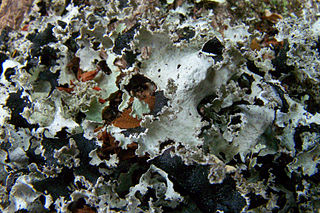
Platismatia is genus of medium to large foliose lichens with rather crinkled lobes. The genus is widespread and contains 10 species. They resemble many other genera of foliose lichens in the family Parmeliaceae, particularly Parmotrema, Cetrelia, and Asahinea. Most species are found in forests on the trunks and branches of conifer trees, although some species grow on rocks.
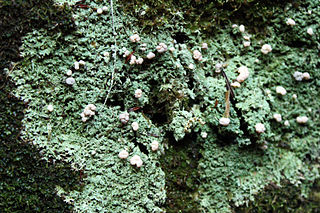
Icmadophila is a genus of crustose lichen. The genus has a widespread distribution in the Northern Hemisphere and contains six species. The only species found in North America, Icmadophila ericetorum, has a mint green crustose thallus that is dotted with bright pink apothecial disks, and is sometimes affectionately referred to as fairy puke. It aggressively grows over mosses on well-rotted wood and peat. It looks very distinctive, but may be confused with species of Dibaeis.

Nodobryoria is a genus of medium to large, reddish-brown lichens that are hair-like to shrubby in shape and grow on conifer trees. The genus contains three species, distributed in North America and Greenland, which were previously included in the genus Bryoria. Nodobryoria is similar in appearance to Bryoria, but is differentiated because it does not contain the polysaccharide lichenin, and it has a unique cortex composed of interlocking cells that look like pieces of a jigsaw puzzle when viewed under a light microscope.
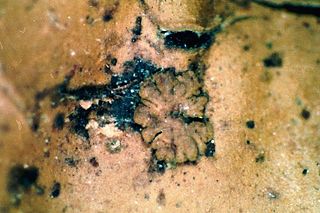
Cephalodia are small gall-like structures found in some species of lichens that contain cyanobacterial symbionts. Cephalodia can occur within the tissues of the lichen, or on its upper or lower surface. Lichens that have both green algal and cyanobacterial symbionts restrict the cyanobacteria to cephalodia. Lichens that have only cyanobacterial symbionts do not have cephalodia: instead the cyanobacteria are widely distributed throughout the lichen. Lichens with cephalodia can fix nitrogen, and can be an important contributor of nitrogen to the ecosystem.
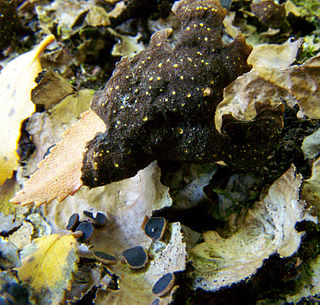
Pseudocyphellae are structures in lichens that appear as tiny pores on the outer surface (the cortex of the lichen. They are caused when there is a break in the cortex of the lichen, and the medullary hyphae extend to the surface. Pseudocyphellae are the same colour as the medulla of the lichen, which is generally white, but can be yellow in some species of Pseudocyphellaria and in Bryoria fremontii. The presence/absence, abundance, colour, and shape of pseudocyphellae can all be diagnostic features used to identify different species. They facilitate gas exchange through the surface of the lichen, and may provide an adaptive advantage in temperate environments.
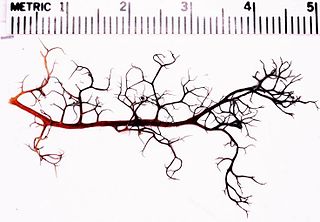
Gowardia is a genus of medium-sized, greyish hair lichens in the family Parmeliaceae. It is a circumpolar genus, mainly restricted to arctic-alpine habitats in northern Canada, Europe, and Russia.

Bryoria is a genus of lichenized fungi in the family Parmeliaceae. Many members of this genus are known as horsehair lichens. The genus has a widespread distribution, especially in boreal and cool temperate areas.
A lichenicolous fungus is a parasitic fungus that only lives on lichen as the host. A lichenicolous fungus is not the same as the fungus that is the component of the lichen, which is known as a lichenized fungus. They are most commonly specific to a given fungus as the host, but they also include a wide range of pathogens, saprotrophs, and commensals. It is estimated there are 3000 species of lichenicolous fungi. More than 1800 species are already described among the Ascomycota and Basidiomycota. More than 95% of lichenicolous fungi described as of 2003 are ascomycetes, in 7 classes and 19 orders. Although Basidiomyces has less than 5% of lichenicolous lichen species, they represent 4 classes and 8 orders. Many lichenicolous species have yet to be assigned a phylogenetic position as of 2003.
Bryoria implexa is a species of horsehair lichen in the family Parmeliaceae.
Bryoria subcana is a species of horsehair lichen in the family Parmeliaceae. It is found in North America and Europe.

Cladonia cornuta or the bighorn cup lichen is a species of fruticose, cup lichen in the family Cladoniaceae. It was first described as a new species by Swedish lichenologist Carl Linnaeus in his seminal 1753 work Species Plantarum. German biologist Georg Franz Hoffmann transferred it to the genus Cladonia in 1791. The lichen has a distribution that is circumpolar, boreal, and arctic. It has also been recorded from the Southern Hemisphere.

Cladonia subulata is a species of fruticose, cup lichen in the family Cladoniaceae. It was first described as a new species by Swedish taxonomist Carl Linnaeus in 1753. It was transferred to the genus Cladonia by Friedrich Heinrich Wiggers in 1780. In North America, the lichen is colloquially known as the antlered powderhorn or antlered cup lichen.
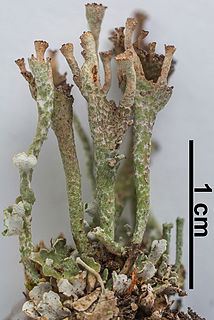
Cladonia cervicornis is a species of cup lichen in the family Cladoniaceae. It was first described by Swedish lichenologist Erik Acharius in 1799 as Lichen cervicornis. Julius von Flotow transferred it to the genus Cladonia in 1849. In North America, it is colloquially known as the ladder lichen or elk's-horn cup lichen.

Pseudephebe minuscula is a species of fruticose lichen in the family Parmeliaceae. In North America, it is known colloquially as coarse rockwool. It has an antitropical distribution.
Bryoria kockiana is a species of horsehair lichen in the family Parmeliaceae. It is found in North America, where it grows from the branches of conifer trees.














